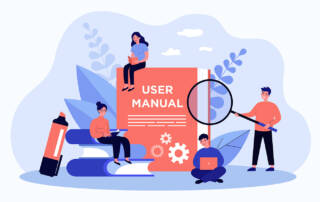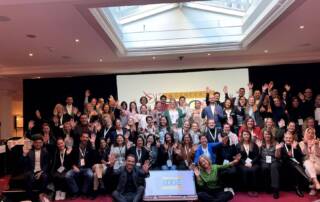




Kim Stevenson
TBE Director & Professional Conference Manager
Company Director Kim Stevenson has been in conferences and hospitality for more than 26 years and loves the diversity of conferences she gets to work on. She shares with us why attention to detail is so important in conference planning, the importance of getting along with your PCO and how technology has changed the process.
Hi Kim, as the Company Director and Conference Manager at Think Business Events what do you see yourself primarily responsible for?
I see my role as primarily focusing on the building of trusting relationships and the management of expectations with both clients and staff alike. With clients it’s about building a relationship where they’re comfortable to trust me and my staff to take them through the full end-to-end conference planning process. With staff it’s about building internal knowledge, a motivating team environment and establishing a clear understanding of individual staff roles and the level of service expected.
When planning a conference what do you consider the most important aspects to consider?
Firstly, considering we’re dealing with committees over a long period of time, good open communication is fundamental. You really need to get to a level where both parties can freely express concerns, debate decisions and most importantly listen to different opinions and needs.
Secondly, with the actual planning of a conference attention to detail is a very important component to remember. A successful conference is the sum of many different parts and each aspect of a conference needs to be delivered at its most optimal to achieve positive success.
A successful conference is the sum of many different parts and each aspect of a conference needs to be delivered at its most optimal to achieve positive success.
What is generally a client’s biggest fear when they find themselves responsible for a conference?
The two big fears which generally tie in one with one another is 1. not selling registration and 2. seeing a financial loss with the conference.
Once again this is solved by making sure that every aspect of the conference is well considered. To drive registrations you need an innovative and quality program that attracts attendees, a good marketing strategy to get the words out and an industry best registration process to ease the process of registering.
To see a positive fiscal outcome for your conference you need to set financial objectives from the outset, create a flexible budget that meets these needs and have the ability to negotiate with suppliers so you can remain within the set budget parameters.
What are the biggest mistakes most conference committees tend to make?
Largely people really underestimate the amount of time it takes to properly plan a conference. There are a number of outcomes that rely upon the response of others (i.e. call for submissions, booking available speakers, registrations) so you’ve got to account for this in your planning. The other mistake is committees have champagne ideas on a beer budget – it’s really important to manage such expectations so you can work within your budget.
Many of your clients often say both you and Denise both have a remarkable ability to stay calm under pressure, what’s the secret?
Our mentor instilled in us that there is a solution to every problem and you just need to calmly work through the situation to achieve a positive outcomes. We both know that stressing in such situations will only make the problems worse and will not put our committees at ease.
To drive registrations you need an innovative and quality program that attracts attendees, a good marketing strategy to get the word out and an industry best registration system to ease the process of registering.
What do you love most about conference management?
I love the diversity of clients and conferences I get to work with. No conference is the same. I also enjoy the challenge of working with associations on limited budgets and making things happening that the committee envisioned. It can be hard work but it’s so worth seeing a happy client at the end of the day.
What would you say has been the biggest change in the industry?
Without a doubt technology and the speed at which new innovations are coming onto the market. It can be quite exciting, however, it also brings short falls such as emails where people expect replies fairly instantaneously. This creates a lot of extra work for the team.
Hire a PCO who knows what they’re doing and can lead you along the right path. Make sure it’s someone you can get along with and trust as the planning process is often in excess of 12 months.
What would be your top tip to someone organising a conference for the first time?
Hire a PCO that knows what they are doing and can lead you along the right path. But most importantly, make sure it’s someone you can get along with and trust as the planning process is often in excess of 12 months.
And lastly, what do you do when you are not conferencing?
You will be able to find me either sampling any of the new restaurants or cafes or planning my next holiday adventure.
Read More of Our Event Thoughts
- Think Business Events Partners with Hidden Disabilities Sunflower to Enhance Accessibility at EventsKim Stevenson2024-11-25T15:30:49+11:00
Think Business Events Partners with Hidden Disabilities Sunflower to Enhance Accessibility at Events
- How To Prepare When Attending Your First ConferenceKim Stevenson2023-03-20T16:07:18+11:00
How To Prepare When Attending Your First Conference
- Kim’s trip to Geneva and the IAPCO EDGE SeminarKim Stevenson2023-01-27T15:19:43+11:00
Kim’s trip to Geneva and the IAPCO EDGE Seminar
- We asked some of our team ‘What’s in your conference kit?’Kim Stevenson2022-11-21T14:46:55+11:00
We asked some of our team ‘What’s in your conference kit?’
- 6 important things to remember when organising an international conferenceKim Stevenson2022-09-30T16:51:56+10:00
6 important things to remember when organising an international conference
- Case Study: The Australian Defence Science, Technology & Research SummitKim Stevenson2022-10-10T10:47:15+11:00
Case Study: The Australian Defence Science, Technology & Research Summit
- Case Study: The Australasian College of DermatologistsKim Stevenson2022-06-09T11:55:32+10:00
Case Study: The Australasian College of Dermatologists









